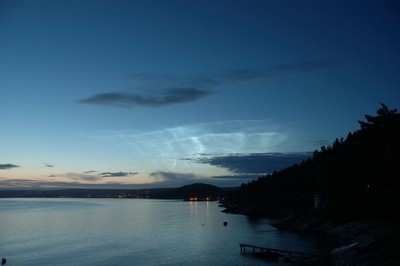What Causes Noctilucent Clouds?
Northern summer has arrived, and that means it's time to watch
out for noctilucent clouds (NLCs). On some summer nights, just
after sunset, NLCs snake across the sky glowing electric
blue-white.
Noctilucent clouds are a mystery: They hover 80 km above Earth
at the very edge of space. Some researchers believe they're a sign
of global warming. Others say they're caused by space dust and
rocket exhaust. Whatever they are, they're beautiful. Normally a
high-latitude phenomenon, NLCs have been seen in recent years as
far south as Colorado and Virginia.
Ash from the Indonesian volcano caused such splendid sunsets
worldwide that evening sky watching became a popular past time. One
sky watcher in particular, a German named T.W. Backhouse who is
often credited with the discovery of noctilucent clouds, noticed
something odd. He stayed outside after the sun had set and, on some
nights, saw wispy filaments glowing electric blue against the black
sky. Scientists of the day figured they were some curious
manifestation of volcanic ash.
Eventually the ash settled and the vivid sunsets of Krakatoa
faded. Yet the noctilucent clouds remained. "It's puzzling," says
Thomas. "Noctilucent clouds have not only persisted, but also
spread." A century ago the clouds were confined to latitudes above
50o; you had to go to places like Scandinavia, Russia and Britain
to see them. In recent years they have been sighted as far south as
Utah and Colorado.
Astronaut Don Pettit is a long-time noctilucent cloud-watcher.
As a staff scientist at the Los Alamos National Laboratory between
1984 and 1996, he studied noctilucent clouds seeded by high-flying
sounding rockets. "Seeing these kinds of clouds [from space] ... is
certainly a joy for us on the ISS," he said on NASA TV more than a
year ago, while in orbit aboard the space station.
"Although NLCs look like they're in space," continues Thomas,
"they're really inside Earth's atmosphere, in a layer called the
mesosphere ranging from 50 to 85 km high." The mesosphere is not
only very cold (-125 C), but also very dry--"one hundred million
times dryer than air from the Sahara desert." Nevertheless, NLCs
are made of water. The clouds consist of tiny ice crystals about
the size of particles in cigarette smoke.
How ice crystals form in the arid mesosphere is the essential
mystery of noctilucent clouds.

Ice crystals in clouds need two things to grow: water molecules
and something for those molecules to stick to--dust, for example.
Water gathering on dust to form droplets or ice crystals is a
process called nucleation. It happens all the time in ordinary
clouds.
Are NLCs a thermometer for climate change? A telltale sign of
meteoroids? Or both? "So much about these clouds is speculative,"
says Thomas.
A NASA spacecraft scheduled for launch in 2006 will provide some
answers. The Aeronomy of Ice in the Mesosphere satellite, or AIM
for short, will orbit Earth at an altitude of 550 km. Although it's
a small satellite, says Thomas, there are many sensors on board.
AIM will take wide angle photos of NLCs, measure their temperatures
and chemical abundances, monitor dusty aerosols, and count
meteoroids raining down on Earth. "For the first time we'll be able
to monitor all the crucial factors at once."
Meanwhile, all we can do is wait ... and watch. There's never
been a better time to see noctilucent clouds. "During the summer
months, look west perhaps 30 minutes to an hour after sunset when
the Sun has dipped 6- to 16-degrees below the horizon," advises
Thomas. If you see luminous blue-white tendrils spreading across
the sky, you've probably spotted an NLC. Observing sites north of
40 degrees latitude are favored.
 ANN's Daily Aero-Linx (05.06.25)
ANN's Daily Aero-Linx (05.06.25) ANN's Daily Aero-Term (05.06.25): Ultrahigh Frequency (UHF)
ANN's Daily Aero-Term (05.06.25): Ultrahigh Frequency (UHF) ANN FAQ: Q&A 101
ANN FAQ: Q&A 101 Classic Aero-TV: Virtual Reality Painting--PPG Leverages Technology for Training
Classic Aero-TV: Virtual Reality Painting--PPG Leverages Technology for Training Airborne 05.02.25: Joby Crewed Milestone, Diamond Club, Canadian Pilot Insurance
Airborne 05.02.25: Joby Crewed Milestone, Diamond Club, Canadian Pilot Insurance



